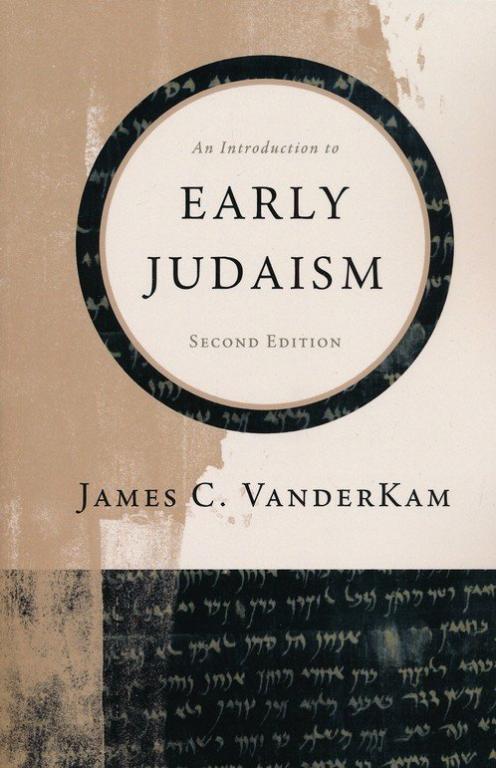James C. Vanderkam has written An Introduction to Early Judaism.
I caught up with James recently to discuss his book.
Enjoy!
What provoked you to write this book?
Since the first edition of An Introduction to Early Judaism was published in 2001, my memory of the circumstances in which it arose is somewhat faded. I do recall that two gentlemen from the Wm. B. Eerdmans Publishing Company suggested I write an introduction to the period, an introduction that would resemble my The Dead Sea Scrolls Today, which Eerdmans had first published in 1994.
That book was geared to a fairly wide audience of educated readers and had sold very well. I had been studying Early Judaism for a long time and thought this sounded like a good idea. There were other introductions to Early Judaism that were on a very technical level and/or were very long and there were some that were much briefer and not written by people who focused their scholarship on that period. I aimed for a place between these extremes and tried to organize the material in clear and helpful way. The second edition was, of course, meant to update the twenty-year-old book and to make other minor changes and corrections.
How long did it take you to write?
Again, my memory is a bit fuzzy, given the passage of time, but I suspect I worked on it specifically, on and off, for about a year. I should add, however, that I was drawing on my own study and research over the preceding 25 years or so. The second edition, which still took a significant amount of effort, went faster, as one might expect. I had been discussing the second edition with an editor at Eerdmans for several years but, once I started on it in earnest, it moved along at a good pace.
Share three main points you are trying to make in the book – three take aways.
First, I wanted to show to readers that, far from lacking interest or importance, the period of Early Judaism (ca. 400 bce-100 ce), was well worth studying. It is important in and of itself and for understanding Judaism in later periods, and some knowledge of it enhances one’s reading of the New Testament.
Second, I aimed to provide ready access to and reliable information about not only the history of the period but also the literature produced by Jewish writers in these centuries. Texts such as the Dead Sea Scrolls have given rise to all sorts of theories, many of which are baseless but well publicized.Consequently, I provided short introductions for each of the texts I treated so that readers would know something about their contents and what experts were saying about them.
Third, I tried to pull together a wide range of information about people and institutions in the final part of the book so that readers could use it as a handy reference for what they might be trying to find regarding the centuries in question.
According to Josephus, thousands of Jews were killed in A.D. 49. Some scholars believe this is what Paul was referring to in 1 Thess. 2 when he said “wrath has come upon them” (the Jews). Can you tell us about these killings? What caused them and how did they take place? And do you believe this is what Paul had in mind in 1 Thess. 2?
Paul’s reference to the wrath of God coming on the Jews (1 Thess 2:16) is too vague to allow one to say much about what he had in mind. If the passage is pointing to something specific that had happened recently, there are options, among which are the great difficulties Jews in Egypt were having in their struggle to keep or gain rights of citizenship, the famine in Judea in the later 40’s ce, and the slaughter at Passover that you mention (Josephus, Ant. 20.105-12).
Passover, with its overtones of liberty and the large crowds that assembled in the temple complex for the festival and the one that immediately followed it, was an occasion when the Romans showed how anxious they were to prevent any troubles by stationing additional forces around the temple. According to Josephus, one of the soldiers posted at the temple exposed himself. The offensive gesture stirred up the Jewish crowd and led to their insulting the Roman governor. Eventually the troops turned on the crowd and supposedly killed 20,000 of them. But whether Paul is referring to this tragic episode I do not know.
On his second journey, Paul circumcised Timothy so the Jews wouldn’t dismiss him. My question is, in the first century, what was the procedure for VERIFYING that someone was circumcised? What, likely, would the Jews who heard Timothy do to verify that he was circumcised?
As far as I know, there is no source from the period of Early Judaism that deals with this subject. Circumcision is obviously a very important practice in Judaism and it was a cause of much difficulty in Early Christianity as Paul’s letters and Acts indicate. The texts from the period do not, however, deal with practical details such as these.
What was the procedure for circumcision for an adult to be circumcised in the first century? what did they use to numb the pain? Who performed them and where?
Again, I am unaware of a source from Early Judaism that deals with these questions. There was debate, as attested by Josephus and Rabbinic literature, about whether proselytes needed to be circumcised. There are biblical references to a father circumcising his sons (Abraham), and Moses’s wife Zipporah circumcised her son (Exodus 4:25).
1 Maccabees 1:60 speaks of women who had their sons circumcised, and 2:46 reports that Mattathias and his men forcibly circumcised boys. In a case like that of Timothy, we read that he was circumcised but no details are given about who did the circumcising or how it was carried out. Flint knives are mentioned as the instruments of circumcision (Zipporah, Joshua). The rule that a boy was to be circumcised on the eighth day is mentioned in various places besides Genesis 17. In the Mishnah (ca. 200 ce) there is specific detail about what is to be done and who is to carry it out (e.g., m. Shabbat 18:3-19:6).
Tell us about the Pharisees and Saduccees and the power they had in the first century.
The Sadducees are supposed to have been drawn from the upper classes, but Pharisees, who are often identified as associated with other levels of society, also included prominent people. As a result, some of them may well have owned extensive properties.
This is not, however, stated in the Gospels as a reason for their opposition to Jesus. He did at times oppose their teachings and, in this way, could be seen as undermining their positions in society. The incident of overturning the tables of the money changers in the temple complex could be seen as attacking an entire system, but there was also a political dimension to their opposition to Jesus (making himself a king).
Why aren’t there any footnotes or endnotes in the book?
I chose not to include footnotes or endnotes in the book because it is, as the title indicates, an introduction. While notes have their obvious value, they do make a book less readable, less attractive to those who are relatively new to the subject. The compromise I adopted was to provide a bibliography for those who wanted to read more and a clear indication of the sources from which I took translations of ancient texts and the passages supporting my statements.
What else would you like people to know about your book?
People may like to know that the book, while it has a lot of information in it, is intended to be accessible and to introduce or further inform readers about a field in which I have worked now for nearly fifty years and which I have found to be so fascinating and worth studying. I hope readers feel something of my enthusiasm for learning about those important centuries—what people did, what they thought, and what they wrote.













